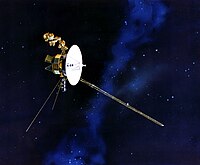V'ger
V'ger (Vejur in the novelization by Gene Roddenberry) is a fictional character in the Star Trek universe. Given life by a race of living machines, V'ger is a sentient being that evolved from Voyager 6, a space probe from the 20th Century that vanished into a black hole. The story of V'ger and its return to earth to seek "the creator" forms the plot for the first feature film in the Star Trek series, Star Trek: The Motion Picture. V'ger's story is also expanded upon in novelisation, most notably William Shatner's The Return. This and other works (both canon and non-canon), speculate that V'ger is a creation of, or the creator of the Borg, a race of cybernetic creatures later featured in Star Trek: The Next Generation.
V'ger's journey
Admiral James T. Kirk is assigned to his old ship, the USS Enterprise, in order to intercept a mysterious cloud approaching the Solar System. The Enterprise finally reaches the core of this cloud, and, through the assimilation of crew member Lt. Ilia by the cloud, Kirk and his crew discover it refers to itself as V'ger and wants to "join with its Creator". Commander Spock, the Enterprise's Science Officer, then dons a spacesuit, exits the Enterprise and moves into V'ger's holographic memory chambers, where he sees a history of V'ger's journey. Kirk, Spock and the other senior crew do not learn that V'ger is in fact the human space probe Voyager 6 until they walk up to it at the film's climax.
They then deduce that, having disappeared during its original mission, Voyager 6 was discovered by sentient mechanical life forms, who, assuming it was an artificial intelligence like themselves, "repaired" it and constructed an enormous ship so that it could complete the mission embedded in its memory banks: Learn all that is learnable. Transmit that information back to the Creator. While on the way back to the Creator's planet (Earth), the knowledge V'ger records leads it to develop consciousness.
As its journey nears its end, V'ger has a crisis of faith, wanting to see the Creator and learn if there is nothing more to its existence than seeking information and bringing it back to the Creator. In this respect, it is an allegory of the search for God by humankind. However, when it first comes into contact with the Enterprise, V'ger refuses to accept humans as "true life forms", to which First Officer Willard Decker replies: "We all create God in our own image."
Spock recognizes that despite its age and experience, it's quite young at heart. He recommends to Kirk that it be treated as such, despite its awesome power. After V'ger states it will "remove the infestation on the Creator's planet"—in other words, humankind—by destroying its surface, Kirk plays on its instinctive want and need for its Creator with this gambit: he tells it he knows why the Creator does not respond to V'ger's repeated calls. He tells the assimilated Lt. Ilia, however, that he will only disclose this information to V'ger directly.

Kirk, Spock, McCoy, the Ilia probe, and Decker are permitted to enter V'ger's central core, where they find the ancient Voyager 6 probe and realize they can trigger its radio transmitter, thereby proving that humankind is V'ger's 'Creator'. V'ger, however, wants to join with its Creator in order to experience levels of understanding and being beyond its cold, logical mind. Decker volunteers, and the two fuse into one as V'ger enters into a higher plane of existence.
Other references
Three novels authored by William Shatner and set after the events of Star Trek Generations propose that the mechanical race that V'ger encounters are in fact the Borg, a society of cyborgs that feature prominently in Star Trek: The Next Generation and later series and films. These novels, however, have not been acknowledged by Paramount as canon, and according to series canon it is unlikely that the Borg would have been responsible for the creation of V'ger.
In contrast to Shatner's novels, the game Star Trek: Legacy states that the origin of the Borg is in fact V'ger, which created them to further its goal of the assimilation of knowledge.
The original Star Trek Encyclopedia does reference that Gene Roddenberry intended the "planet of living machines" that V'ger encountered on its journey to be, in fact, the Borg homeworld.
In the animated television series Futurama, a "Plymouth V'ger" is featured in a commercial for Malfunctioning Eddies' Rocket Car Emporium, punning on the similarly-named automobile, the Plymouth Voyager.
The Design Of V'ger
The huge model used for the motion control photography of V'ger, which ran the entire length of the motion control camera's track, was created from a sketch drawn by Syd Mead. Mead is well known for his designs of futuristic mega-structures, more of which can be seen in the 1982 film Blade Runner.
